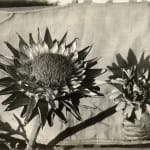[Luther Burbank]
Substantial Photographic Archive Documenting the Work of the Famed Botanist and Agricultural Scientist, 1910s-20s
Silver prints (225)
Various sizes; most 6 x 8 inches, some smaller, a few larger
With publisher's credit and specimen identification, in colored pencil, verso
With publisher's credit and specimen identification, in colored pencil, verso
Further images
-
(View a larger image of thumbnail 1
)

-
(View a larger image of thumbnail 2
)

-
(View a larger image of thumbnail 3
)

-
(View a larger image of thumbnail 4
)

-
(View a larger image of thumbnail 5
)

-
(View a larger image of thumbnail 6
)

-
(View a larger image of thumbnail 7
)

-
(View a larger image of thumbnail 8
)

-
(View a larger image of thumbnail 9
)

-
(View a larger image of thumbnail 10
)

A substantial and graphically dynamic archive documenting the myriad horticultural accomplishments of Luther Burbank. The collection contains hundreds of photographic studies, with scores of beautiful, artfully crafted still-lives reminiscent of...
A substantial and graphically dynamic archive documenting the myriad horticultural accomplishments of Luther Burbank. The collection contains hundreds of photographic studies, with scores of beautiful, artfully crafted still-lives reminiscent of the work of Karl Blossfeldt or Imogen Cunningham. There are also many images of the specimens in situ, at Burbank’s experimental farm. Likely used as proofs for his many publications, the photographs were produced by Burbank’s publisher and all-around hype man, Oscar Binner.
The majority of the photographs are double-weight prints, most measuring 6 by 8 inches, though a few are larger or smaller. Most of the specimens are identified on the verso of the prints and represented are scores of fruits, flowers, grasses and vegetables.
A pioneering botanist and horticulturist, Burbank developed more than 800 strains and varieties of plants over his 55-year career and is one of the most important American figures in 20th-century agricultural sciences. One somewhat overlooked aspect of his long and storied career is his relationship with Oscar Binner, who was often misnamed in the papers as “Oscar Dinner.” In his article “Selling Luther Burbank,” author and Santa Rosa historian Jeff Elliot describes Binner as an “underrated figure in the Burbank canon…Part manager, part counselor, part promoter, Binner aimed to be the Col. Parker to Burbank’s Elvis.” And that it was Binner “who masterminded a national campaign that brought Burbank acclaim greater than he had ever known before.”
After successfully founding and running the Binner Engraving company in the 1880s and 90s, Oscar Binner sold the firm in 1905 to work for Burbank full time. Binner opened a “Bureau of Information” on Santa Rosa Avenue in front of Burbank’s farm where, as Elliot writes, “the public was invited to buy seeds, bulbs, and color lithographs of Burbank plants, suitable for framing. Binner produced dozens of pamphlets by and about Burbank and tried to sell shares in the Oscar E. Binner Company ("Luther Burbank's Publishers") for the publication of the still in-progress Burbank encyclopedia.”
Their relationship ended in 1912, with the incorporation of the semi-autonomous Luther Burbank Press. It is possible that these photographs were sold off around this time, as they ended up in the possession of the New York photo agency Brown Brothers.
The majority of the photographs are double-weight prints, most measuring 6 by 8 inches, though a few are larger or smaller. Most of the specimens are identified on the verso of the prints and represented are scores of fruits, flowers, grasses and vegetables.
A pioneering botanist and horticulturist, Burbank developed more than 800 strains and varieties of plants over his 55-year career and is one of the most important American figures in 20th-century agricultural sciences. One somewhat overlooked aspect of his long and storied career is his relationship with Oscar Binner, who was often misnamed in the papers as “Oscar Dinner.” In his article “Selling Luther Burbank,” author and Santa Rosa historian Jeff Elliot describes Binner as an “underrated figure in the Burbank canon…Part manager, part counselor, part promoter, Binner aimed to be the Col. Parker to Burbank’s Elvis.” And that it was Binner “who masterminded a national campaign that brought Burbank acclaim greater than he had ever known before.”
After successfully founding and running the Binner Engraving company in the 1880s and 90s, Oscar Binner sold the firm in 1905 to work for Burbank full time. Binner opened a “Bureau of Information” on Santa Rosa Avenue in front of Burbank’s farm where, as Elliot writes, “the public was invited to buy seeds, bulbs, and color lithographs of Burbank plants, suitable for framing. Binner produced dozens of pamphlets by and about Burbank and tried to sell shares in the Oscar E. Binner Company ("Luther Burbank's Publishers") for the publication of the still in-progress Burbank encyclopedia.”
Their relationship ended in 1912, with the incorporation of the semi-autonomous Luther Burbank Press. It is possible that these photographs were sold off around this time, as they ended up in the possession of the New York photo agency Brown Brothers.
![[Luther Burbank], Substantial Photographic Archive Documenting the Work of the Famed Botanist and Agricultural Scientist, 1910s-20s](https://artlogic-res.cloudinary.com/w_1600,h_1600,c_limit,f_auto,fl_lossy,q_auto/artlogicstorage/dollc/images/view/6653f8030d19a3e1c7248ff044dd2dfdj/daniel-oliver-luther-burbank-substantial-photographic-archive-documenting-the-work-of-the-famed-botanist-and-agricultural-scientist-1910s-20s.jpg)
![[Luther Burbank], Substantial Photographic Archive Documenting the Work of the Famed Botanist and Agricultural Scientist, 1910s-20s](https://artlogic-res.cloudinary.com/w_1600,h_1600,c_limit,f_auto,fl_lossy,q_auto/artlogicstorage/dollc/images/view/b8e07479e397a5c17b07e0dd7fdbaf6dj/daniel-oliver-luther-burbank-substantial-photographic-archive-documenting-the-work-of-the-famed-botanist-and-agricultural-scientist-1910s-20s.jpg)
![[Luther Burbank], Substantial Photographic Archive Documenting the Work of the Famed Botanist and Agricultural Scientist, 1910s-20s](https://artlogic-res.cloudinary.com/w_1600,h_1600,c_limit,f_auto,fl_lossy,q_auto/artlogicstorage/dollc/images/view/39daa3f5f1e8cff78918fef2596d7496j/daniel-oliver-luther-burbank-substantial-photographic-archive-documenting-the-work-of-the-famed-botanist-and-agricultural-scientist-1910s-20s.jpg)
![[Luther Burbank], Substantial Photographic Archive Documenting the Work of the Famed Botanist and Agricultural Scientist, 1910s-20s](https://artlogic-res.cloudinary.com/w_1600,h_1600,c_limit,f_auto,fl_lossy,q_auto/artlogicstorage/dollc/images/view/cf454696b98acfd03faefa6917cbab67j/daniel-oliver-luther-burbank-substantial-photographic-archive-documenting-the-work-of-the-famed-botanist-and-agricultural-scientist-1910s-20s.jpg)
![[Luther Burbank], Substantial Photographic Archive Documenting the Work of the Famed Botanist and Agricultural Scientist, 1910s-20s](https://artlogic-res.cloudinary.com/w_1600,h_1600,c_limit,f_auto,fl_lossy,q_auto/artlogicstorage/dollc/images/view/5cb98d89cb22c45715d105108bed2cbbj/daniel-oliver-luther-burbank-substantial-photographic-archive-documenting-the-work-of-the-famed-botanist-and-agricultural-scientist-1910s-20s.jpg)
![[Luther Burbank], Substantial Photographic Archive Documenting the Work of the Famed Botanist and Agricultural Scientist, 1910s-20s](https://artlogic-res.cloudinary.com/w_1600,h_1600,c_limit,f_auto,fl_lossy,q_auto/artlogicstorage/dollc/images/view/73963a1f4e771becf6cfddd93408cb56j/daniel-oliver-luther-burbank-substantial-photographic-archive-documenting-the-work-of-the-famed-botanist-and-agricultural-scientist-1910s-20s.jpg)
![[Luther Burbank], Substantial Photographic Archive Documenting the Work of the Famed Botanist and Agricultural Scientist, 1910s-20s](https://artlogic-res.cloudinary.com/w_1600,h_1600,c_limit,f_auto,fl_lossy,q_auto/artlogicstorage/dollc/images/view/3308ff8858dc540a0e54209b13e088fdj/daniel-oliver-luther-burbank-substantial-photographic-archive-documenting-the-work-of-the-famed-botanist-and-agricultural-scientist-1910s-20s.jpg)
![[Luther Burbank], Substantial Photographic Archive Documenting the Work of the Famed Botanist and Agricultural Scientist, 1910s-20s](https://artlogic-res.cloudinary.com/w_1600,h_1600,c_limit,f_auto,fl_lossy,q_auto/artlogicstorage/dollc/images/view/ebddbc0c72688615eb5172beaa7d465fj/daniel-oliver-luther-burbank-substantial-photographic-archive-documenting-the-work-of-the-famed-botanist-and-agricultural-scientist-1910s-20s.jpg)
![[Luther Burbank], Substantial Photographic Archive Documenting the Work of the Famed Botanist and Agricultural Scientist, 1910s-20s](https://artlogic-res.cloudinary.com/w_1600,h_1600,c_limit,f_auto,fl_lossy,q_auto/artlogicstorage/dollc/images/view/60c2a42bdf90036b06c66e3b99dcaae6j/daniel-oliver-luther-burbank-substantial-photographic-archive-documenting-the-work-of-the-famed-botanist-and-agricultural-scientist-1910s-20s.jpg)
![[Luther Burbank], Substantial Photographic Archive Documenting the Work of the Famed Botanist and Agricultural Scientist, 1910s-20s](https://artlogic-res.cloudinary.com/w_1600,h_1600,c_limit,f_auto,fl_lossy,q_auto/artlogicstorage/dollc/images/view/7875ec17c2afc9da74310d558efa0adbj/daniel-oliver-luther-burbank-substantial-photographic-archive-documenting-the-work-of-the-famed-botanist-and-agricultural-scientist-1910s-20s.jpg)